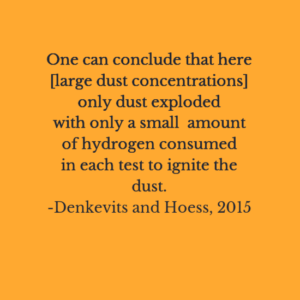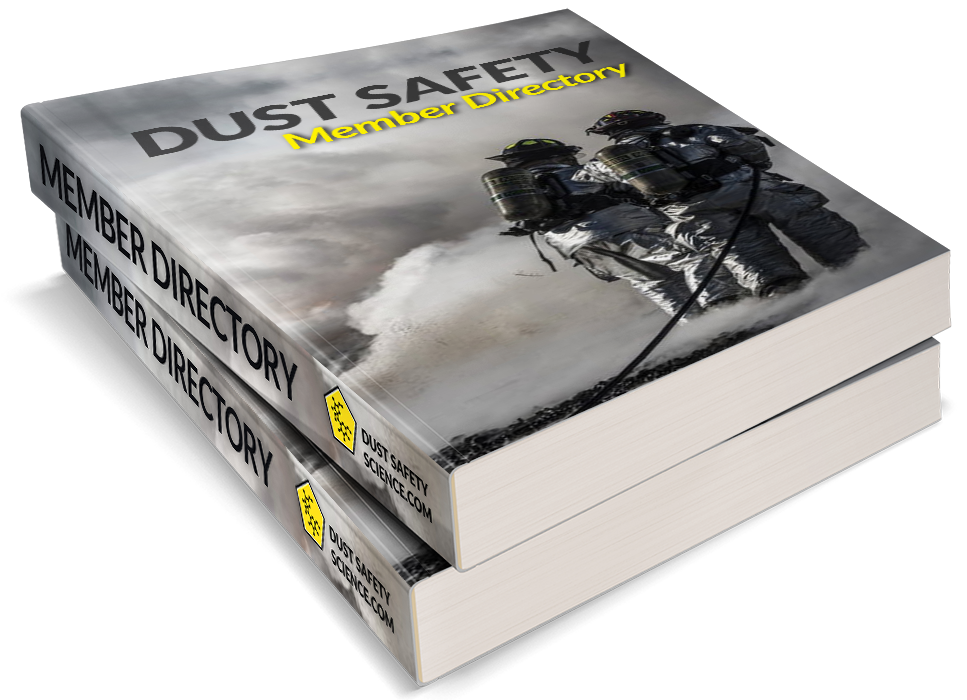1-Sentence-Summary: Adding hydrogen gas to highly reactive 1 µm aluminum dust allowed the dust to ignite with spark ignition and increased the rate of pressure rise by 2-3 times over the fuels individually.
Authors: A. Denkevits and B. Hoess
Read in: Four Minutes
Favourite quote from the paper:

The authors of this paper perform explosion testing on hybrid mixtures of hydrogen gas and aluminum dust. The 1 µm aluminum dust is a substitute for Beryllium which is highly toxic. Explosion of beryllium and hydrogen mixtures has been identified as a possible hazard scenario under loss-of-coolant accidents in thermonuclear reactors.
The aluminum dust concentrations are between 100 and 1200 g/m3. The gas concentration is between 8 and 20% by volume. The explosions are performed in a 20-L spherical chamber using a weak spark ignition. The standard ignition delay of 60 ms appears to have been used.
Graphs of the explosion results are shown including pressure verses time curves, rate of pressure rise verses time curves, and maximum pressure and maximum rate of pressure rise verses concentration. Mass spectroscopy is also used to determine the gaseous composition of the explosion products.
Three of the main findings from this paper are:
- The dust and gas combustion process was coupled at almost all concentrations tested
- Under almost all conditions addition of aluminum dust to the hydrogen gas resulted in increased maximum pressure and rate of pressure rise.
- At the highest dust concentrations (1200 g/m3) the hydrogen gas only acted to ignite the dust but was not involved in the subsequent combustion process.
The following sections outline the main findings in more detail. The interested reader is encouraged to view the complete article at the link provided below.
Finding #1: Dust combustion contributed to the hybrid explosion at all concentrations
In previous work the current authors found three different explosion processes for hybrid mixtures (Denkevits, 2007): gas-only explosion, two-stage explosion, and coupled single-stage explosion. In the current work the highly reactive aluminum dust always contributed to the explosion and all tests completed showed either the two-step or single-step process.
Two-stage explosions occurred at low fuel concentrations such as [100 g/m3, 8%], [100 g/m3, 10%], [200 g/m3, 8%], and [400 g/m3, 8%]. At all higher dust and gas concentrations single-stage coupled explosions were seen were the dust and gas reacted on the same timescale.
Finding #2: Hybrid mixtures resulted in more severe explosions than the constituent fuels individually
In all cases the explosion severity of the hybrid mixtures was higher than the individual fuels at their respective concentrations. In the two-stage process, maximum pressure was increased by the presence of the second fuel. Furthermore, the maximum rate of pressure rise of the secondary aluminum explosion was always higher than the initial hydrogen explosion.
In the single-stage explosion process the combustion of the fuels overlapped leading to significant enhancement of explosion severity. For example at 400 /m3 the hybrid rate of pressure rise was increased from 140 bar/s with 8% hydrogen gas to almost 2000 bar/s for 14% hydrogen gas. This is also much higher than the hydrogen gas alone which had a rate of pressure rise of 700 bar/s at 14% and 1000 bar/s at 18%.
Finding #3: At 1200 g/m3 hydrogen gas contributed to ignition but not subsequent explosion of the mixture
At the highest aluminum dust concentrations tested an interesting phenomena was seen. Violent explosions occurred but the mass spectroscopy showed that very little of the hydrogen gas was consumed. Furthermore, the addition of large amounts of hydrogen (up to 20%) had a minor effect on rate of pressure rise. The large amounts of hydrogen also appear to have an “inerting” effect on pressure.
The authors propose that only a small amount of hydrogen gas is consumed to initiate the dust explosion. After that the dust reacts faster than the gas consuming all of the oxygen. They also demonstrate that the maximum rate of pressure rise for the hybrid mixture (approximately 2100 bar/s) is close to the aluminum dust alone with 10 kJ chemical ignitors (2280 bar/s).
My Personal Take-Aways From
“Hybrid H2/Al Dust Explosions in Siwek Sphere”
This paper demonstrates the significant hazard posed by mixtures of highly reactive dusts and gases. Although previous papers have demonstrated hybrid explosion enhancement (e.g., Pilao et al., 2006, Dufaud, 2008, Garcia-Agreda et al., 2011, and Sanchirico et al., 2011), the magnitudes of the explosion rate of pressure rise were significantly lower than those presented here. In all cases the hybrid explosion was more severe than the fuels individually and the hydrogen allowed the dust to be ignited with a low spark energy. Lastly, at high dust concentrations the aluminum dust exploded as if a 10 kJ chemical ignitor was used.
The pressure time traces shown in this work allow for analysis of the relative combustion timescales of the fuels. It also shows that the two timescales approach each other between dust concentrations of 100-200 g/m3 and gas concentrations of 8-12%. The finding that little hydrogen is consumed at the worst case dust concentrations is also very interesting and important for process safety analysis.
This work is recommended for anyone studying hybrid explosion of highly reactive dusts such as metals. It is also very important for people working in the nuclear industry as these fuels are modeled after recognized upset conditions in these environments. The interested reader is also encouraged to review the other papers published these authors (Denkevits 2007, and Denkevits, 2010) as well as the numerical modelling efforts being undertaken by this group (e.g., see Redlinger, 2008)
Full Citation: [bibtex file=references.bib key=Denkevits2015]
[otw_shortcode_button href=”http://www.sciencedirect.com/science/article/pii/S0950423015001047″ size=”medium” icon_position=”left” shape=”square”]> > Get The Article [/otw_shortcode_button]
